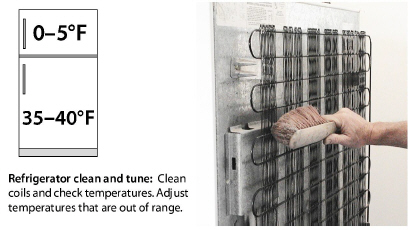
10.1 Refrigerator Replacement and Maintenance
Refrigerators built after 1993 use less electricity than refrigerators built before that year. Another efficiency increase occurred in 1999 in the refrigerator industry.
10.1.1 Refrigerator Replacement
Comply with the following requirements when replacing refrigerators.
✓ The new refrigerator must fit the existing space.
✓ The new refrigerator must be 40% more efficient than the minimum federal standards or be labeled Energy Star.
✓ The new refrigerator must have a minimum one-year warranty.
✓ Take refrigerators that are replaced to a facility that is licensed to reclaim their refrigerant and recycle the refrigerator’s parts.
✓ No refrigerator, taken out of service, may be returned to service by sale, barter, or for free.
✓ Instruct the client about location and operation of energy controls such as the thermostats for the refrigerator and freezer.
Some clients use two or more refrigerators in their homes, and this practice results in high electricity usage. Suggest to these clients to consolidate food storage into a large single refrigerator.

10.1.2 Refrigerator Cleaning and Tuning
|
SWS Detail: 7.8001.2 Cleaning and Tuning Existing Refrigerators and Freezers |
Cleaning and tuning an existing refrigerator can increase its efficiency. Follow these procedures.
✓ Clean dirt off clogged coils.
✓ Move objects that block airflow around the refrigerator, and ask the client to store the objects elsewhere.
✓ Measure refrigerator temperature and verify that it is between 35° and 40° F. Otherwise re-set the thermostat to this temperature range.
✓ Measure the freezer temperature, and verify that it is more than or equal to 0° F. If it is colder that 0°, re-set the freezer’s thermostat to 0° F.
✓ Check the condensation-control switch. If the condensation control is on, the refrigerator door or door frame is being heated. Try turning the switch to “energy saver” which turns the heating elements off. If frost forms on the door, turn the control back on.
✓ Explain the function of the condensation control to clients. If the energy-saver setting isn’t adequate for very humid weather, the occupants could toggle setting.
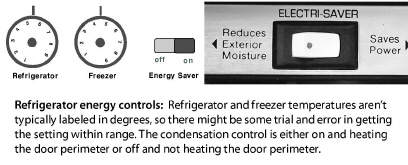
10.1.3 Refrigerator Metering Protocol
Older refrigerators use from 1000 to 2000 kWh per year. Newer Energy Star refrigerators use less than 400 kWh per year. You need a minimum of two hours to accurately measure refrigerator energy consumption using a recording watt-hour meter.
There are two common options for evaluating refrigerator energy consumption for replacement.
1. The first option is to follow the metering procedure presented here.
2. If metering isn’t feasible, use the database housed in the WA Software. If the refrigerator doesn’t work find another source of usage information such as http://www.kouba-cavallo.com/refmods.htm
Metering Accuracy Issues
A number of unusual circumstances could reduce the accuracy of the metering, including the following.
• A quantity of warm food recently placed in the refrigerator.
• Abnormally high or low ambient temperature. For example: refrigerators in garages during the summer or winter; or refrigerators in vacant homes where heating or cooling systems aren’t operating.
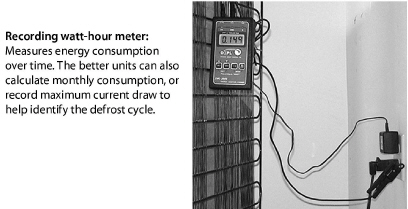
Refrigerator Metering Procedure
If the refrigerator is an automatic-defrost model, you could measure an inaccurate reading if the unit goes into the electric defrost mode during the test period. The following test protocol includes provisions to prevent the defrost mode from activating.
1. Determine if the refrigerator is equipped with automatic defrost. This is usually stated on the manufacturer’s data plate or on the outside of the unit. If the refrigerator is equipped with a manual defrost, proceed to step 3.
2. If the unit is equipped with automatic defrost, follow this sub-procedure.
a. Locate the defrost timer. This small electrical-control box is located in the refrigerator or behind the front kick-plate. The defrost timer may also be located on the rear of the unit.
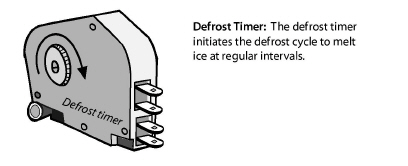
b. Open the defrost timer and locate the advance pinion. This shaft usually has a screwdriver slot to allow you to manually advance the timer.
c. Turn the timer clockwise (you can break the timer if you turn it counter-clockwise) until you hear a loud click. This turns the defrost heaters on. Turn it further until it clicks loudly again, turning the defrost heaters off.
d. You can now perform your measurement since the timer won’t call for defrost heat again for several hours.
3. Connect the refrigerator to a recording watt-hour meter. Run the test for at least two hours. You don’t need to stop at two hours, and a longer measurement is better. During the test, avoid opening the refrigerator, or do so briefly.
4. At the end of the test, read the kilowatt/hours of consumption measured by the meter. Divide this number by the number of hours in the test. This gives you the number of kilowatt-hours consumed each hour. Multiply this number times the total number of hours in a year (8760 hours per year). The product of this calculation is the annual kilowatt-hours of electrical usage.
5. Remove the meter and plug the refrigerator back into its outlet.
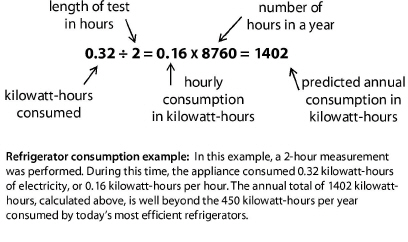
|
kWh/hour |
kWh/year |
kWh/hour |
kWh/year |
|---|---|---|---|
|
0.23 |
2000 |
0.16 |
1400 |
|
0.22 |
1900 |
0.15 |
1300 |
|
0.21 |
1800 |
0.14 |
1200 |
|
0.19 |
1700 |
0.13 |
1100 |
|
0.18 |
1600 |
0.11 |
1000 |
|
0.17 |
1500 |
0.10 |
900 |